Longxing Temple: Uncover the Secrets of China’s Most Enigmatic Monastery
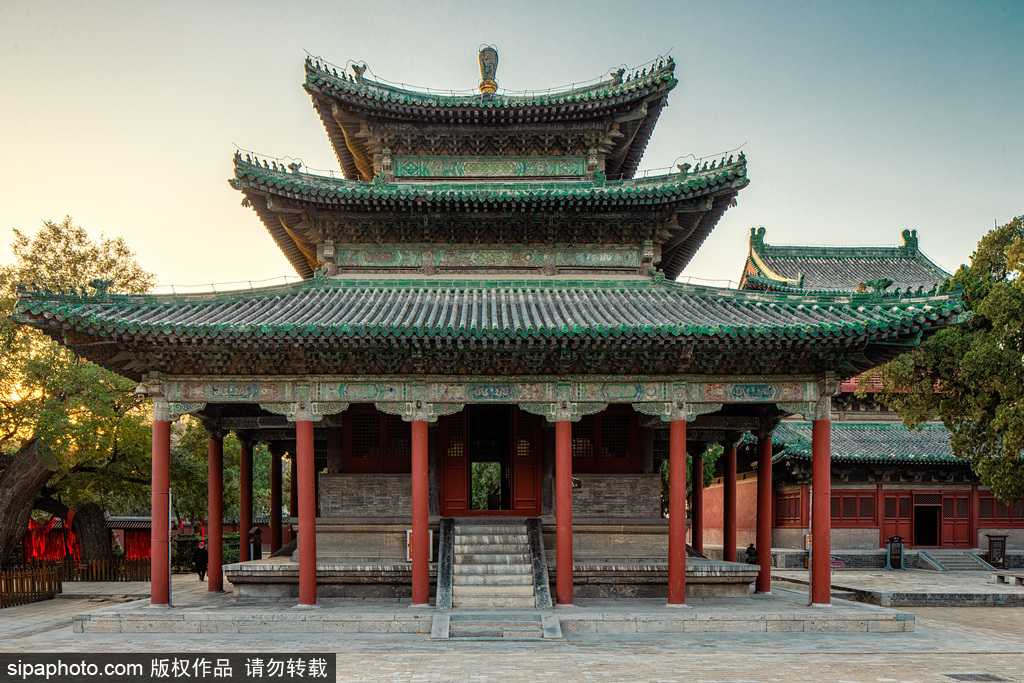
An Essential Guide to Visiting Longxing Temple
In This Guide
- An Essential Guide to Visiting Longxing Temple
- The Rich History and Legends of Longxing Temple
- Main Highlights: What You Absolutely Can’t Miss
- Planning Your Visit: A Practical Guide
- Tickets: Prices, Booking, and Tips
- How to Get There: A Complete Transportation Guide
- Local Cuisine and Accommodation Nearby
- Frequently Asked Questions
- Final Thoughts on Your Trip
Nestled in the heart of Zhengding County, Longxing Temple (隆兴寺) stands as a testament to China’s rich cultural and historical heritage. Often referred to as the “Big Buddha Temple,” it boasts stunning architecture that dates back to the Song Dynasty, making it one of the most significant Buddhist temples in the region. As you step onto the temple grounds, you are not just entering a place of worship; you are embarking on a journey through centuries of history, art, and spirituality.
A Glimpse into History
Longxing Temple was originally built in the 6th century, during the Northern Qi Dynasty, and has been a focal point for both religious practice and architectural innovation. The temple’s grand halls and intricate wood carvings reflect the artistic prowess of ancient craftsmen, while the towering statues of deities and historical figures speak volumes of the temple’s religious importance. The most notable feature is the impressive copper statue of Guanyin, the Bodhisattva of compassion, which captivates visitors with its serene expression and majestic presence.
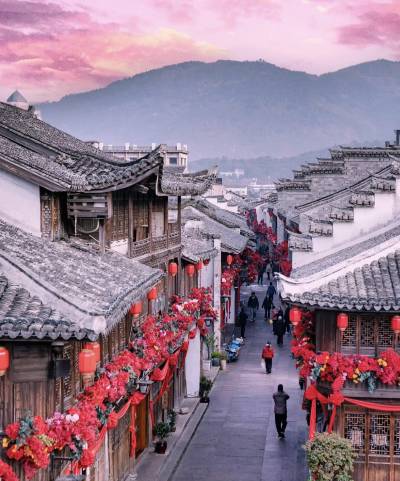
Longxing Temple.
What to Expect
Visiting Longxing Temple offers a unique opportunity to experience Chinese culture and Buddhism up close. Here’s what you can look forward to during your visit:
-
Stunning Architecture: The temple complex showcases traditional Chinese architectural styles, with ornate roofs, intricate wooden carvings, and serene courtyards that provide a tranquil atmosphere.
-
Cultural Significance: Expect to learn about the temple’s historical importance through well-maintained signage in both Chinese and English, making it accessible to international travelers.
-
Peaceful Grounds: Take a leisurely stroll through the beautifully landscaped gardens, where you can find quiet spots for reflection and appreciate the harmony between nature and architecture.
-
Less Crowded Experience: Unlike some of the more famous temples in China, Longxing Temple is often less crowded, allowing you to immerse yourself in its historical ambiance without the chaos of large tourist groups.
Practical Information
Planning your visit is essential to make the most of this cultural gem. Here are some tips:
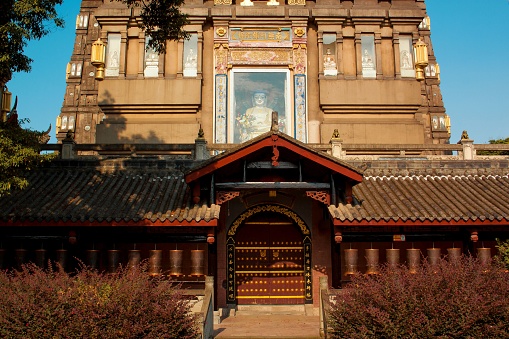
Longxing Temple.
-
Opening Hours: The temple is open daily from 9:00 AM to 4:00 PM. Be sure to check the schedule before your visit, as hours may vary during holidays or special events.
-
Getting There: Longxing Temple is conveniently located about a 30- to 45-minute drive from downtown Shijiazhuang. Public transportation options include bus routes that can take you to Zhengding Nanmen, followed by a short walk to the temple.
-
Entrance Fee: A nominal entrance fee of approximately 50 yuan grants you access to the temple and its grounds, an investment well worth the enriching experience.
-
Recommendations: For the best experience, consider visiting during the spring or autumn months when the weather is pleasant, and the gardens are in full bloom. If you prefer a quieter visit, try to avoid weekends and public holidays when local visitors flock to the site.
Longxing Temple is not just a destination; it’s a portal to another time, a place where history and spirituality intertwine. Whether you are a history enthusiast, an art lover, or simply seeking a moment of peace, this temple will leave an indelible mark on your journey through China’s rich tapestry of culture.
The Rich History and Legends of Longxing Temple
Longxing Temple, often referred to as the “Big Buddha Temple,” is a treasure trove of Chinese history and culture nestled in the heart of Zhengding County, Hebei Province. With a history that stretches back over a millennium, this site not only serves as an architectural marvel but also as a testament to the rich tapestry of Buddhist practices and legends that have flourished in China.
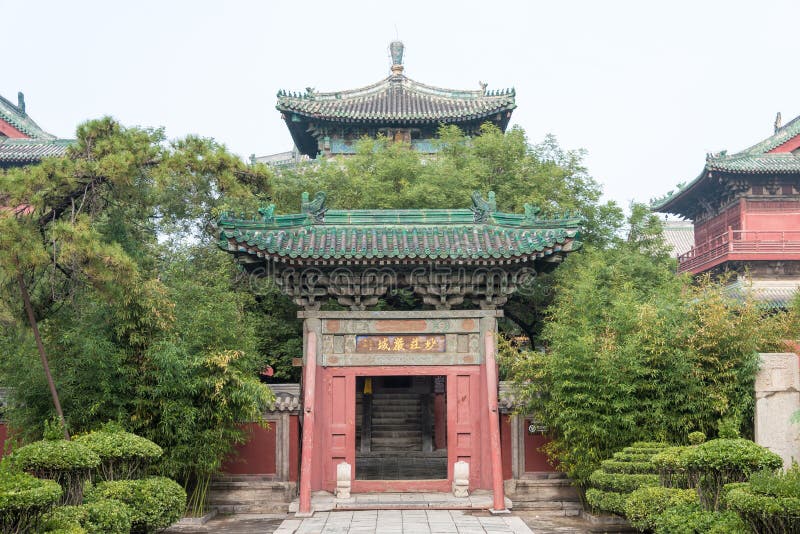
Longxing Temple.
A Historical Overview
The origins of Longxing Temple date back to the Song Dynasty (960–1279), a period renowned for its advancements in culture, technology, and philosophy. Initially built in 1055, the temple was constructed to honor the Buddhist deity Avalokiteshvara, known in Chinese as Guanyin. Over the centuries, it has undergone numerous renovations and expansions, particularly during the Yuan (1271–1368) and Ming (1368–1644) dynasties, which helped solidify its status as a major Buddhist center in Northern China.
One of the temple’s most notable features is its massive wooden statue of Guanyin, crafted during the Tang Dynasty (618–907). This magnificent sculpture stands as a symbol of compassion and mercy, embodying the essence of Buddhist teachings. The intricate details of the statue reflect the artistic prowess of the era, making it a must-see for visitors interested in traditional craftsmanship.
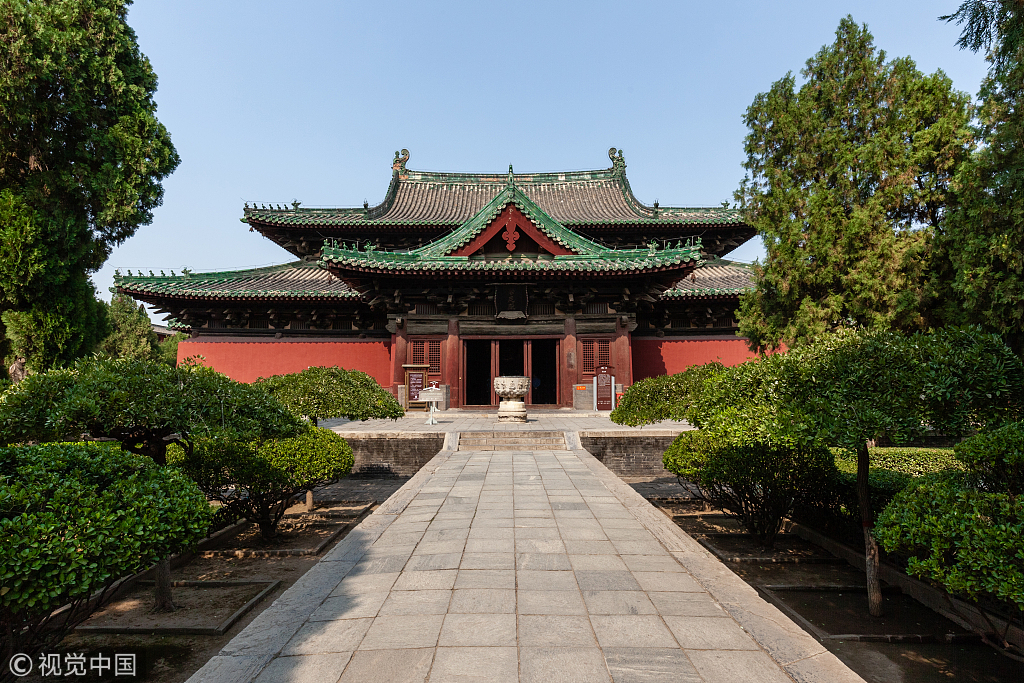
Longxing Temple.
Architectural Significance
Longxing Temple showcases an impressive blend of architectural styles that represent various historical periods. The temple complex is adorned with majestic halls, serene courtyards, and beautifully landscaped gardens, creating a tranquil environment for meditation and reflection. The use of traditional Chinese architectural elements, such as upturned eaves and ornate carvings, enhances the temple’s aesthetic appeal, drawing architecture enthusiasts from around the globe.
The temple’s layout follows the classic design of Chinese Buddhist temples, featuring a central hall that houses the main deities, flanked by smaller halls dedicated to other important figures in Buddhism. Visitors can wander through the intricate pathways, taking in the beauty of the surroundings while exploring the rich symbolism embedded in the architecture.
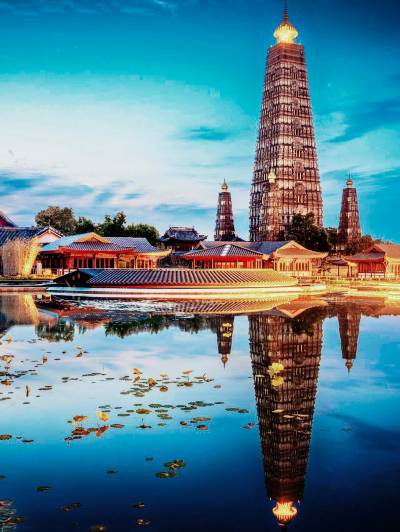
Longxing Temple.
Legends and Spiritual Significance
Throughout its long history, Longxing Temple has been the backdrop for numerous legends. One popular tale speaks of a miraculous event involving the statue of Guanyin, where it is said that she appeared in a dream to a devout monk, guiding him to the exact location of a hidden treasure. This treasure, believed to be the relics of a revered Buddhist master, is said to bless the temple and its visitors with prosperity and peace.
Another legend associated with Longxing Temple involves the “Three Great Treasures,” which are believed to provide protection and good fortune to those who pay their respects. These treasures include sacred scriptures, ancient artifacts, and a rare stone that is thought to possess healing properties. Pilgrims and devotees come from far and wide to seek blessings from these revered items, reinforcing the temple’s role as a spiritual sanctuary.
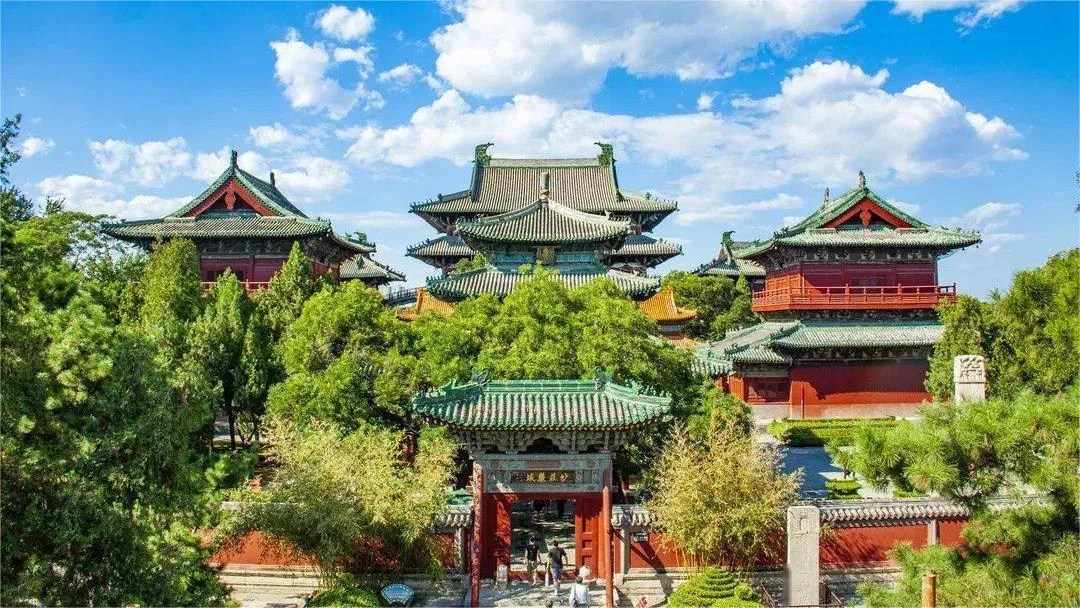
Longxing Temple.
Cultural Impact and Modern Relevance
Today, Longxing Temple remains a vital center for Buddhist worship and cultural exchange. It attracts thousands of visitors each year, both local and international, eager to experience its serene atmosphere and rich history. The temple also hosts various cultural events and festivals, promoting traditional practices and teachings of Buddhism to a new generation.
For international travelers interested in Chinese history and culture, Longxing Temple offers a unique glimpse into the spiritual life of the region, along with its architectural beauty and legendary tales. Whether you are seeking enlightenment, artistic inspiration, or simply a peaceful retreat from the bustling world, Longxing Temple is a destination that promises to enrich your understanding of China’s profound cultural heritage.
In conclusion, the allure of Longxing Temple lies not only in its stunning architecture and serene gardens but also in the rich history and legends that continue to resonate with those who walk its hallowed grounds.

Longxing Temple.
Main Highlights: What You Absolutely Can’t Miss
Longxing Temple, known as 隆兴寺 in Mandarin, stands as one of the most significant Buddhist temples in China, located in the historic Zhengding County of Hebei province. A visit to this temple is not only a journey through serene landscapes but also an exploration of rich Chinese history and architecture. Here are the main highlights that make Longxing Temple an unmissable destination for international travelers keen on delving into China’s cultural heritage.
1. Architectural Marvel
The temple complex showcases stunning examples of traditional Chinese architecture, with intricate wooden carvings and majestic pagodas that reflect the grandeur of the Song Dynasty. Be sure to take a moment to admire the Bodhisattva statue, an impressive wooden figure from the Tang Dynasty, which is a testament to the artistic prowess of ancient China.
2. Historical Significance
Dating back to the 6th century, Longxing Temple boasts a history that intertwines with China’s Buddhist heritage. As one of the oldest temples in the region, it has served as a pivotal site for religious practice and cultural exchange. The historical artifacts and inscriptions scattered throughout the grounds offer valuable insights into the evolution of Buddhism in China.
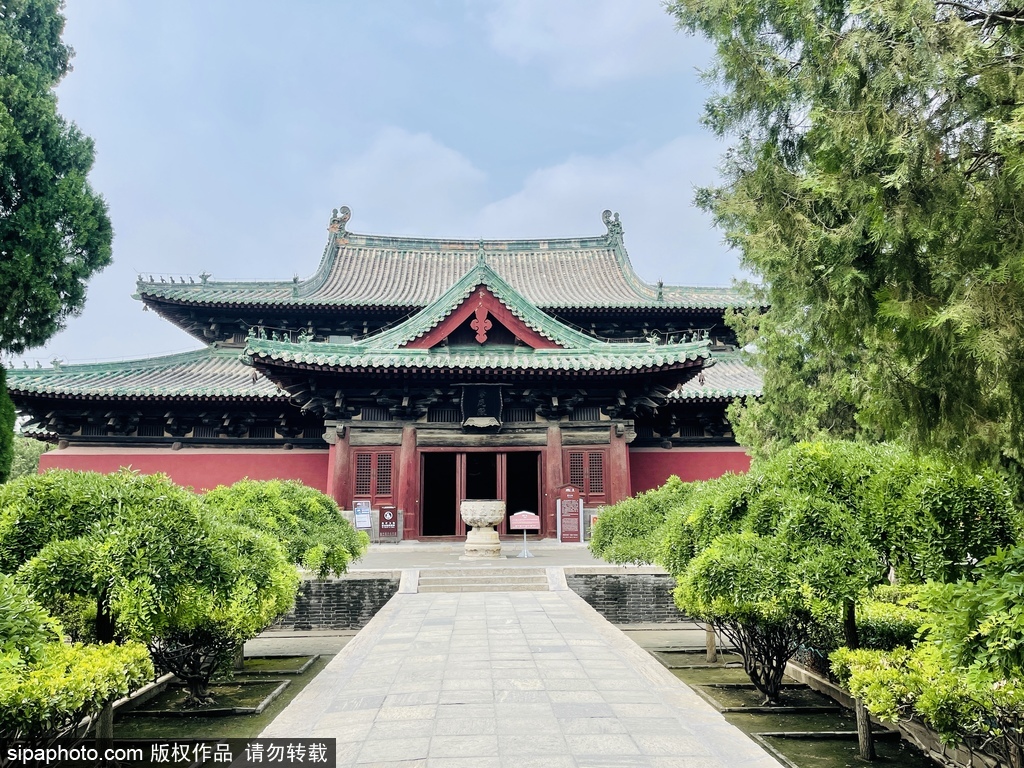
Longxing Temple.
3. Serene Gardens
Wander through the temple’s beautifully maintained gardens, which provide a tranquil escape from the bustle of modern life. The gardens are perfect for leisurely strolls, offering picturesque views that enhance the spiritual ambiance of the temple. The contrast between the natural beauty and the architectural splendor creates a harmonious environment that invites contemplation.
4. The Great Guanyin
At the heart of Longxing Temple lies the Great Guanyin, a colossal copper statue that draws visitors from far and wide. This figure symbolizes compassion and mercy, embodying the core values of Buddhism. Standing before this magnificent statue, one can feel a sense of peace and reverence, making it a highlight of any visit.
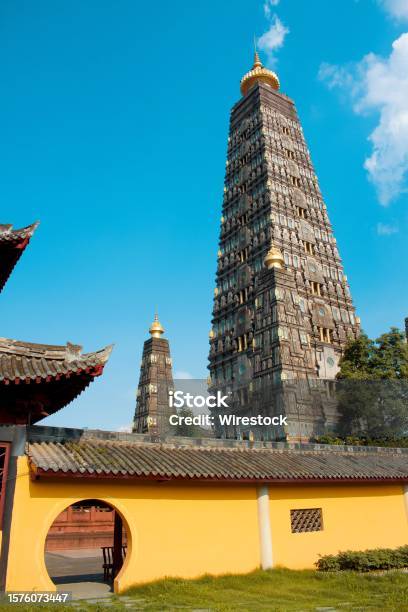
Longxing Temple.
5. Accessibility and Visitor Experience
Conveniently located just a 20-minute cab ride from downtown Shijiazhuang, Longxing Temple is easily accessible for travelers. The temple is open daily, but it’s advisable to visit during off-peak seasons to fully appreciate its tranquility and to avoid the summer crowds. English signage throughout the complex ensures that international visitors can navigate and understand the significance of various sites within the temple grounds.
6. Nearby Attractions
While exploring Longxing Temple, consider venturing to nearby historical sites such as Guanghui Temple, Zhaoyun Temple, and the Brick Tower. Each of these locations adds to the rich tapestry of Zhengding’s historical narrative and provides further context to your visit.
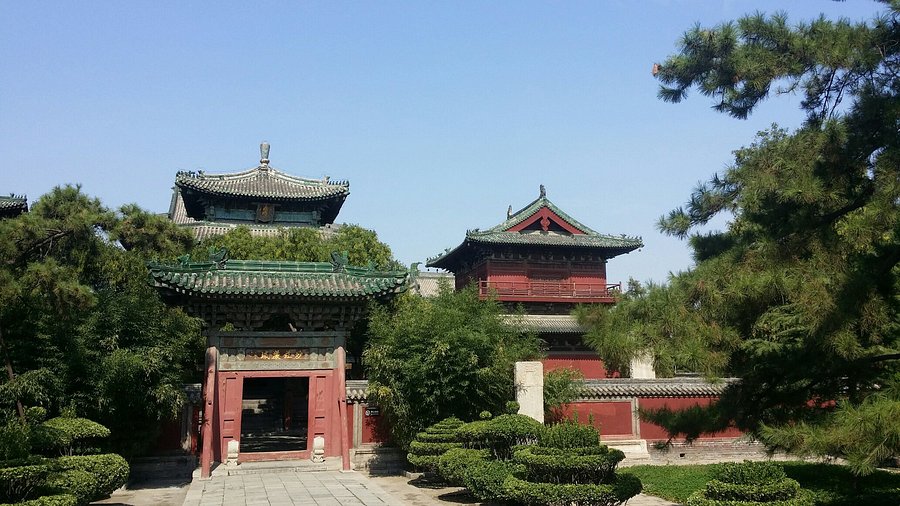
Longxing Temple.
7. Cultural Insights
Engage with the local culture by participating in traditional tea ceremonies or observing monks in practice. These experiences can deepen your understanding of Buddhist rituals and the significance of harmony in daily life.
Conclusion
Longxing Temple is not just a place of worship; it is a sanctuary of history, culture, and art. Whether you are an avid historian, an architecture enthusiast, or simply seeking a peaceful retreat, this temple offers a remarkable glimpse into the spiritual heart of China. Don’t miss out on this enriching experience during your travels!
Planning Your Visit: A Practical Guide
Your Essential Guide to Visiting Longxing Temple
If you’re eager to immerse yourself in China’s rich tapestry of history and culture, a visit to Longxing Temple, also known as the Great Buddha Temple, should be on your itinerary. Nestled in the historic town of Zhengding, this site is a treasure trove of architectural beauty and spiritual significance. Here’s everything you need to know before you go.
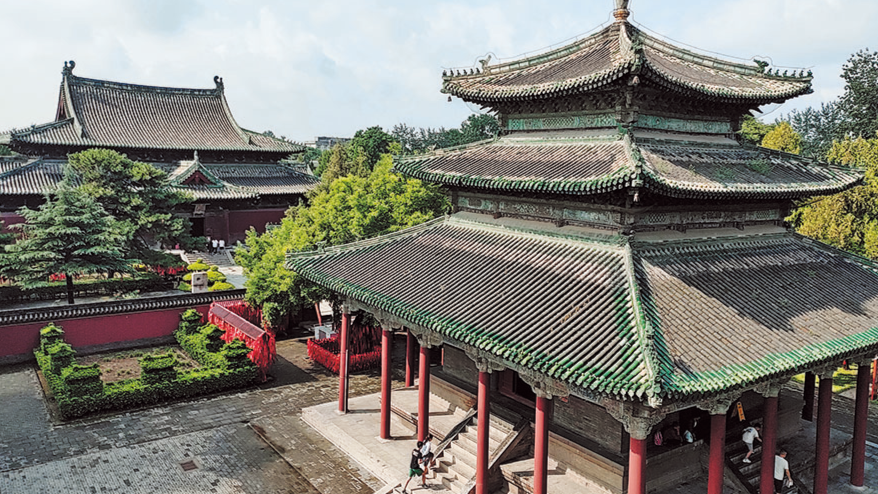
Longxing Temple.
Getting There
- Location: Longxing Temple is located at No. 109 Zhongshan East Road, Zhengding County, Hebei Province, China.
- Transportation:
- By Taxi: It’s about a 20-minute ride from downtown Shijiazhuang. Taxis are a convenient option for direct access.
- By Public Transport: You can take Bus 177 from the Medical University bus stop to Zhengding Nanmen (正定南门). From there, it’s a short walk into the walled town where the temple is situated. Be aware that using a transport card may require an additional fare payment when exiting the bus.
Opening Hours
- Daily: 9:00 AM – 4:00 PM
- Note: The temple closes promptly at 4 PM, so plan your visit accordingly to ensure you have enough time to explore the grounds.
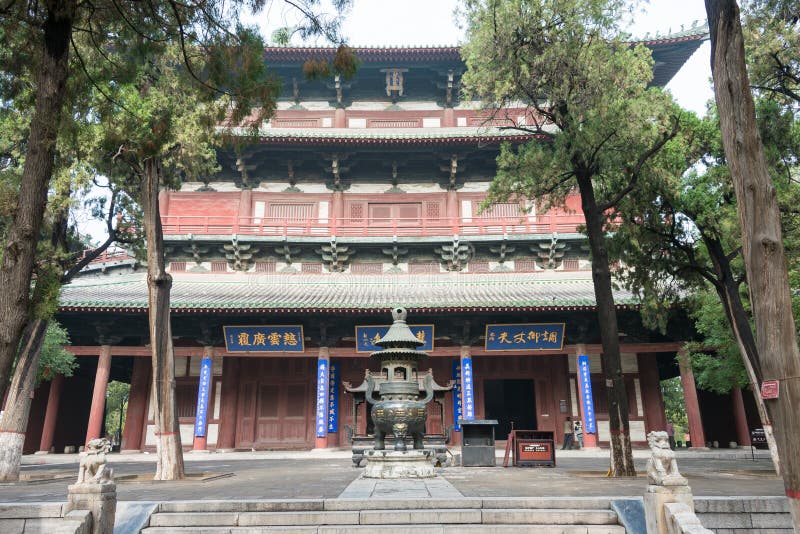
Longxing Temple.
Admission Fees
- Entry Fee: Approximately 50 yuan. This fee grants you access to the temple and its grounds, which are well-maintained and rich in history.
What to Expect
Longxing Temple is not just a religious site but also an architectural marvel showcasing traditional Chinese design. Here’s what to look forward to:
- Stunning Architecture: Marvel at the intricate wooden carvings and the impressive copper Guanyin statue, a highlight of the temple.
- Beautiful Grounds: The temple grounds are serene and meticulously cared for, providing a lovely environment for a leisurely stroll.
- Educational Experience: Informational signs are available in both English and Mandarin, making it easy for international visitors to learn about the temple’s significance and history.
Recommended Duration
- Time to Allocate: Plan to spend at least 1-2 hours at the temple to fully appreciate its beauty and historical context. If you enjoy photography or wish to meditate in the tranquil surroundings, consider extending your visit.
Tips for Your Visit
- Best Time to Visit: To avoid large crowds, consider visiting during the weekdays or early mornings. Summer can be particularly busy, so if you prefer a quieter experience, plan your trip outside of peak tourist season.
- Wear Comfortable Shoes: The temple’s grounds feature uneven terrain, so sturdy footwear is recommended.
- Photography: Bring your camera, as the temple and its intricate details offer fantastic photo opportunities.
Nearby Attractions
While in Zhengding, take the opportunity to explore additional points of interest:
- Rongguo House: A historic residence showcasing traditional architecture.
- Guanghui Temple and Huata Tower: Another beautiful temple worth visiting, located just a short distance away.
- Moni Palace: Known for its ancient ruins and religious significance.
Dining Options
If you’re feeling peckish after your visit, consider dining at HuangGong Restaurant, which is located about 0.6 miles from the temple and offers a variety of seafood dishes.
Final Thoughts
Longxing Temple is a hidden gem that provides a glimpse into China’s spiritual heritage and architectural excellence. Whether you are a history buff, an architecture enthusiast, or simply looking for a peaceful retreat, this temple promises a rewarding experience. Plan your visit wisely, and allow yourself to be transported back in time amidst the beauty of Zhengding.
Tickets: Prices, Booking, and Tips
When planning your visit to Longxing Temple, a remarkable site steeped in history and architectural beauty, it’s essential to have a clear understanding of the ticketing process, including prices, booking options, and tips to enhance your experience.
Ticket Prices
Visiting Longxing Temple is relatively affordable, making it accessible for international travelers and locals alike. As of 2023, the entrance fee is 50 Chinese Yuan (CNY) for adults. Students and seniors may benefit from discounted rates, so it’s worth inquiring about any applicable reductions at the ticket office.
Booking Options
You have a couple of options when it comes to securing your admission:
-
On-Site Purchase: Tickets can be purchased directly at the entrance. This is a straightforward method, especially if you’re already in the area and decide to visit spontaneously.
-
Online Reservations: Although not mandatory, some travelers prefer booking in advance through various travel platforms or local tourism websites. This can save you time and help you avoid potential queues, especially during peak tourist seasons.
Visiting Hours
To make the most of your visit, be mindful of the temple’s operating hours:
– Open Daily: 9:00 AM – 4:00 PM
– Note that the temple closes at 4:00 PM, so plan to arrive with enough time to explore the grounds and appreciate the stunning architecture and serene atmosphere.
Tips for a Better Experience
-
Timing Your Visit: If possible, avoid weekends and public holidays, as these are peak times and can lead to larger crowds. Early mornings or late afternoons during weekdays tend to be quieter.
-
Dress Appropriately: As a place of worship, it’s recommended to wear respectful attire. Comfortable shoes are also a must, as you may encounter uneven surfaces throughout the temple grounds.
-
Explore the Surroundings: The temple is located within a historically rich area. Allocate some time to visit nearby attractions like the Rongguo House or the Huata Tower, which are just a short walk away.
-
Language Support: Many informational signs at the temple are available in both Chinese and English, ensuring that you can appreciate the historical context and significance of what you are seeing.
-
Plan for Weather: The temple features both indoor and outdoor areas. If visiting during the summer, prepare for the heat and crowds. On clearer days, the outdoor gardens and surrounding scenery are particularly lovely.
By following these guidelines, you can ensure a fulfilling and enriching visit to Longxing Temple, immersing yourself in the profound history and cultural heritage it embodies. Enjoy your journey through this magnificent slice of Chinese history!
How to Get There: A Complete Transportation Guide
Journey to Longxing Temple: Your Comprehensive Transportation Guide
Visiting Longxing Temple (隆兴寺), one of the most significant Buddhist temples in China, is an enriching experience for those interested in history and culture. Nestled in Zhengding County, just a short distance from Shijiazhuang, this ancient site is accessible through various transportation options. Here’s how you can reach this magnificent temple with ease.
By Air
Nearest Airport:
– Shijiazhuang Zhengding International Airport (CSX)
Located approximately 30 kilometers from the temple, this is the most convenient airport for international travelers.
Airport Transfer Options:
– Taxi: The quickest option, taking about 30 minutes, costs around 100-150 RMB (15-22 USD).
– Airport Shuttle: Look for shuttle services that can drop you at major points in Shijiazhuang. From there, you can take a taxi or public transport to the temple.
By Train
Main Train Station:
– Shijiazhuang Railway Station
This is the primary rail hub connecting various major cities in China.
Getting to Longxing Temple:
– Taxi: A taxi from the train station to Longxing Temple takes about 45 minutes and costs approximately 80-120 RMB (12-18 USD).
– Public Bus: You can take Bus No. 177 from the station. Get off at Zhengding Nanmen (正定南门) and walk into the walled town. The temple is a short walk from there.
By Bus
Local Buses:
– Bus No. 177: This bus runs regularly from key locations, including the Medical University Bus Stop, to Zhengding Nanmen. It’s an economical option, costing around 2-5 RMB (0.30-0.75 USD).
– Bus No. 19: Another option that connects Shijiazhuang to Zhengding County.
Note: Ensure you have a transport card for easier payment, but be mindful that you might be required to pay again when leaving a different payment zone.
By Taxi or Ride-Hailing Services
Using ride-hailing apps like Didi is a convenient option. A trip from downtown Shijiazhuang will typically take about 40-50 minutes and cost between 80-150 RMB (12-22 USD) depending on traffic.
Travel Tips
- Timing Your Visit: Longxing Temple is best visited in the morning or late afternoon to avoid crowds, especially during the summer months when tourist traffic peaks.
- Dress Accordingly: As with many religious sites, modest attire is recommended.
- Plan Your Return: If you’re using public transportation, be sure to check the return schedule, particularly if visiting in the evening. The temple usually closes by 4 PM, so plan accordingly.
Final Thoughts
Whether you choose to travel by air, train, or bus, reaching Longxing Temple is straightforward and offers a glimpse into the rich history and culture of China. Immerse yourself in the serene atmosphere of this ancient temple, and don’t forget to explore the surrounding area, which boasts other historical attractions as well! Safe travels!
Local Cuisine and Accommodation Nearby
When visiting Longxing Temple, a profound journey into China’s rich history and culture, indulging in the local cuisine and finding comfortable accommodation nearby can enhance your experience. Here’s a guide to savoring the flavors of Zhengding County and securing a restful stay.
Culinary Delights
Zhengding offers a delightful range of local dishes that cater to various palates. Here are a couple of must-try restaurants:
-
HuangGong Restaurant
Just a short walk from Longxing Temple, HuangGong Restaurant is known for its fresh seafood and traditional Chinese dishes. The atmosphere is welcoming, making it a perfect spot to unwind after a day of exploring. Be sure to try their steamed fish and sweet and sour ribs. -
Zhengding Noodle House
For a quick and authentic meal, head to Zhengding Noodle House. This local gem serves a variety of hand-pulled noodles that are both delicious and filling. Their spicy chili oil noodles and beef broth noodles are favorites among locals and travelers alike.
Accommodation Options
After a day spent exploring the serene grounds of Longxing Temple, you will want a comfortable place to rest. Here are some nearby accommodations:
-
Zhengding International Hotel
Located approximately 10 minutes from the temple, this hotel offers modern amenities and a touch of luxury. Guests can enjoy spacious rooms, an on-site restaurant, and easy access to local attractions. The breakfast buffet is particularly praised for its variety. -
Shijiazhuang Longxing Boutique Hotel
This charming boutique hotel is just a stone’s throw away from the temple. With its elegant décor and attentive service, it provides a cozy atmosphere that reflects the local culture. Be sure to inquire about their guided tours to nearby historical sites. -
Zhengding Ancient Town Guesthouse
For those seeking a more immersive experience, consider staying in a guesthouse located within the ancient town. This option offers a unique glimpse into local life and the chance to interact with residents. The guesthouse provides traditional meals, allowing you to savor local flavors right at your doorstep.
Final Thoughts
Combining a visit to Longxing Temple with regional culinary experiences and comfortable accommodations will create a well-rounded journey through Zhengding’s historical landscape. Whether you indulge in local dishes or settle into a cozy guesthouse, you are sure to leave with lasting memories of this remarkable area.
Frequently Asked Questions
Common Questions About Longxing Temple
1. What is Longxing Temple known for?
Longxing Temple, also referred to as the Big Buddha Temple, is renowned for its stunning traditional Chinese architecture and historical significance. It features a striking copper statue of Guanyin and houses numerous ancient artifacts dating back to the Song Dynasty.
2. What are the opening hours?
Longxing Temple is open daily from 9:00 AM to 4:00 PM. It is advisable to arrive early to avoid the crowds, especially during the summer months.
3. How much is the entrance fee?
The entrance fee to Longxing Temple is 50 yuan. This modest fee grants you access to its beautiful grounds and historic buildings, making it a worthwhile investment for history and culture enthusiasts.
4. How do I get to Longxing Temple?
Longxing Temple is conveniently located about a 20- to 45-minute drive from downtown Shijiazhuang. You can take a taxi or use public transportation, such as bus 177, which departs from the Hebei Medical University bus stop.
5. What should I wear when visiting?
Comfortable footwear is recommended, as you will encounter uneven steps and pathways throughout the temple grounds. Additionally, respectful attire is advised in accordance with cultural norms—avoid overly casual clothing.
6. Are there English signs and guides available?
Yes, Longxing Temple provides English translations for most informational signs, making it accessible for international visitors. While guides are not always available, the clear signage helps enhance your understanding of the site’s historical context.
7. What other attractions are nearby?
The area surrounding Longxing Temple is rich in cultural heritage. Nearby attractions include the Rongguo House, Guanghui Temple, and Huata Tower, all within a short distance, making them ideal for a day of exploration.
8. Is Longxing Temple suitable for families?
Absolutely! Longxing Temple offers an engaging experience for families, with beautiful gardens and a tranquil atmosphere. Children can enjoy exploring the grounds while learning about Chinese history and culture in an educational setting.
Final Thoughts on Your Trip
As you conclude your journey to Longxing Temple, take a moment to reflect on the rich tapestry of history, architecture, and spiritual significance that this site embodies. Nestled in the serene surroundings of Zhengding County, Longxing Temple serves not only as a religious sanctuary but also as a testament to China’s enduring cultural heritage.
A Journey Through Time
Visiting Longxing Temple is akin to stepping back in time. The temple, with its origins dating back to the Song Dynasty, showcases exquisite architectural styles and intricate wood carvings that narrate stories of devotion and artistry. The impressive statue of Guanyin, a focal point of the temple, captures the imagination and reverence of all who visit.
Tips for Your Visit
- Best Time to Visit: To fully enjoy the tranquility of the temple grounds, consider visiting during the shoulder seasons of spring or autumn, when the weather is mild and the crowds are thinner.
- Explore the Grounds: Beyond the main hall, take the time to wander through the beautifully maintained gardens that offer a peaceful retreat and stunning views of the temple’s architecture.
- Plan Your Timing: The temple is open daily from 9 AM to 4 PM, allowing you ample opportunity to immerse yourself in its beauty.
Final Reflections
As you walk through the ancient pathways of Longxing Temple, let the serene atmosphere wash over you. Whether you are a history enthusiast, an art lover, or a seeker of spiritual solace, this temple promises an enriching experience. Remember, each visit to a site like Longxing is not just about witnessing the past; it’s about connecting with the present and understanding the profound cultural narratives that continue to shape China today.
Carrying the Experience Home
Take with you not only photographs but also the stories and reflections sparked by your visit. Longxing Temple is more than a destination; it’s an invitation to explore the depths of Chinese history and culture, enriching your understanding of a land steeped in tradition. As you leave, may you carry a piece of its tranquility and wisdom into your own life.